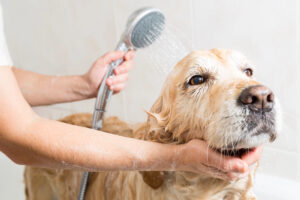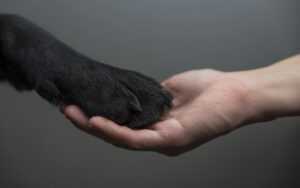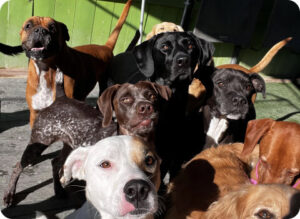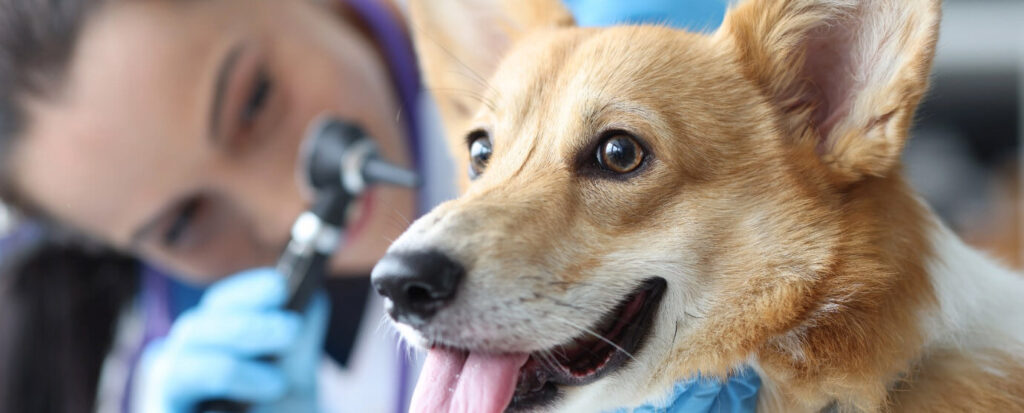
Spring Sniffles: Identifying And Alleviating Your Dog’s Seasonal Allergies
Hey there, dog lovers! As the flowers bloom and the sun shines brighter, it’s time for us to talk about something that might be bugging our furry friends – seasonal allergies! That’s right, just like us humans, our adorable pooches can also suffer from the sneezy, itchy madness that comes with spring.
It’s super important to recognize and treat our dog’s allergies, not only to keep them comfortable and happy but also to prevent any potential health complications. So, buckle up and join us on this journey to become experts on sniffles and sneezes, and learn how to keep our four-legged friends wagging their tails all season long!

Boarding Clients!*Discount does not apply during holiday/peak rate periods.

Common Allergies Affecting Dogs In Spring
As the world comes back to life after winter’s slumber, there are a few pesky allergens lurking around that can make our dogs lives a little less enjoyable. Let’s dive into some of the most common culprits causing those itchy woes in spring:
Pollen From Trees, Grasses, And Flowers
Just like us, our canine companions can be sensitive to pollen. When the trees, grasses, and flowers start to bloom, they release pollen into the air, and our dogs may have a reaction to it. It can stick to their fur and skin, leading to all sorts of itchy and sneezy troubles.
Mold Spores
Mold is a sneaky little thing that loves damp and humid environments. With the arrival of spring showers, mold can grow both indoors and outdoors. Mold spores can cause allergic reactions in our dogs when they inhale them or come into contact with them.
Dust Mites
These microscopic critters are found all around our homes, and they thrive in the warm, cozy environment that spring brings. They hang out in bedding, carpets, and upholstery, and their presence can cause itchy skin and watery eyes in our dogs.
Insect Bites (Fleas, Ticks, Etc.)
As the temperatures rise, so does the population of insects like fleas and ticks. These pesky little bugs can cause a lot of discomfort for our dogs when they bite, and some dogs can even be allergic to their saliva. This can lead to severe itching, skin irritation, and even infections if not addressed.
So, now that we know some of the common allergens that might be causing our dogs to itch and sneeze in spring, we can take action to help them enjoy the season without all the sniffling and scratching. Let’s work together to make spring a time of joy and play for our four-legged family members!

Recognizing The Symptoms Of Seasonal Allergies In Dogs
To help our furry friends feel their best during spring, it’s essential to keep an eye out for any signs that they might be suffering from seasonal allergies. Here’s a handy list of symptoms to watch for in your dog:
Itchy Skin And Excessive Scratching
One of the most noticeable signs of allergies in dogs is itchy skin that leads to excessive scratching. If your pup can’t seem to stop scratching, it might be time to investigate the cause.
Red, Irritated Eyes
Just like us, dogs can get red, watery, and irritated eyes when they’re dealing with allergies. You might notice your dog rubbing its face on the ground or pawing at its eyes.
Sneezing, Coughing, And Wheezing
Dogs can experience respiratory symptoms like sneezing, coughing, and wheezing when allergens irritate their airways. These symptoms can be uncomfortable and may even make it difficult for them to breathe.
Ear Infections
Allergies can lead to ear infections in dogs, especially if they’re scratching their ears a lot. If your dog’s ears seem red, swollen, or smelly, it’s time to schedule a visit to the vet.
Licking Or Biting Paws
Dogs might lick or bite at their paws when they’re itchy or irritated due to allergies. This can cause the skin on their paws to become red, inflamed, and even infected.
Hair Loss And Skin Sores
When dogs constantly scratch their skin due to allergies, they can end up with hair loss and open sores. This not only looks uncomfortable but can also lead to infections if left untreated.
If you spot any of these symptoms in your dog, it’s a good idea to check in with your veterinarian to figure out the cause and get some relief for your pup. After all, spring should be a time of fun and frolicking for our canine companions, not a season of sniffles and itchiness!

Diagnosing Your Dog’s Allergies
When it comes to figuring out what’s causing your dog’s allergy symptoms, it’s time to call in the experts! Let’s go through the process of diagnosing your dog’s allergies and getting them back to their happy, tail-wagging selves.
Consultation With A Veterinarian
The first step in diagnosing your dog’s allergies is to have a chat with your trusted veterinarian. They’ll ask about your dog’s symptoms, medical history, and any changes in their environment or diet. This information helps your vet determine if allergies are the likely culprit and which tests to perform next.
Allergy Testing Methods (Blood Tests, Skin Tests, Etc.)
There are a few different methods your vet might use to test for allergies. Blood tests can detect allergen-specific antibodies in your dog’s bloodstream, while skin tests involve introducing small amounts of potential allergens to the skin to see if there’s a reaction. Both methods have their pros and cons, and your vet will choose the most suitable test for your dog’s situation.
Identifying The Specific Allergens
Once your vet has the test results, they’ll work with you to pinpoint the specific allergen(s) causing your dog’s discomfort. This might involve analyzing the test results, considering your dog’s environment, and potentially even recommending an elimination diet for food allergies. Identifying the allergen is crucial to creating an effective treatment plan tailored to your dog’s needs.
Getting to the root of your dog’s allergy issues might take a bit of time and patience, but it’s well worth it! With the right diagnosis, you’ll be able to help your furry friend enjoy the spring season without all the sneezing, itching, and scratching that’s been getting in the way of their fun.

Treatment Options For Seasonal Allergies In Dogs
Now that we’ve got a handle on diagnosing your dog’s allergies, let’s explore some treatment options to help them feel better and enjoy spring to the fullest!
Allergy Medications
Your vet may prescribe allergy medications like antihistamines or corticosteroids to help manage your dog’s symptoms. These medications can help reduce inflammation, itching, and other uncomfortable symptoms associated with allergies. It’s essential to follow your vet’s instructions and dosage recommendations for these medications.
Topical Treatments
Soothing creams, shampoos, or sprays designed for dogs with sensitive skin can help provide relief from itching and irritation. Make sure to choose products specifically formulated for pets and follow the instructions for use carefully.
Immunotherapy
For some dogs, immunotherapy can be an effective long-term solution for managing allergies. This treatment involves gradually exposing your dog to small amounts of the allergen, either through shots or oral drops, to help build up their tolerance. This process can take several months to a year, but it can lead to a significant improvement in your dog’s allergy symptoms.
Preventative Measures
To help minimize your dog’s exposure to allergens, consider implementing some preventative measures. Regular grooming, including bathing and brushing, can help remove allergens from your dog’s fur. Using flea and tick preventatives can also help protect your dog from insect bites that may trigger allergies.
Environmental Changes
Making some changes around your home can help reduce your dog’s exposure to allergens. Air purifiers can help remove allergens like pollen and dust mites from the air, while frequent vacuuming can help keep your floors and carpets clean. Washing your dog’s bedding regularly and wiping down surfaces can also help minimize allergens in your home.
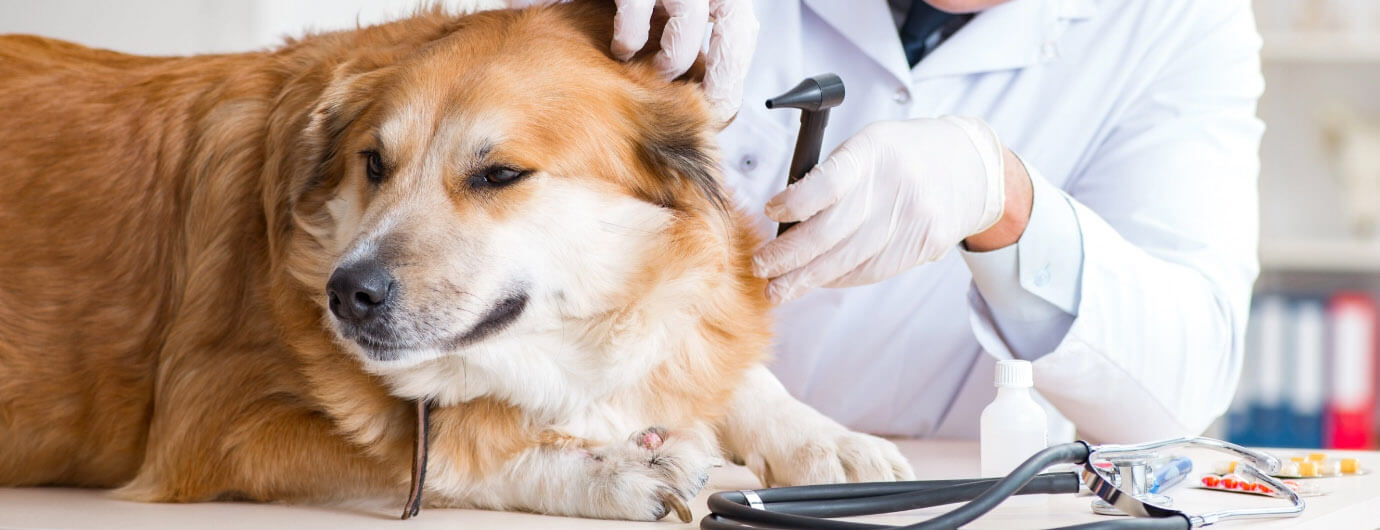
Tips For Managing Your Dog’s Allergies At Home
Once you have a treatment plan in place, there are a few additional steps you can take at home to help your dog feel more comfortable and keep their allergies in check. Let’s go through some tips for managing your dog’s allergies right at home!
Monitoring Your Dog’s Exposure To Allergens
Keep an eye on local pollen counts and try to limit your dog’s outdoor time on high pollen days. Wiping your dog’s paws and coat with a damp cloth after walks can also help remove allergens before they have a chance to cause any itchiness.
Regular Grooming And Bathing
A well-groomed dog is a happy dog! Regular brushing helps remove allergens from your dog’s fur and distributes natural oils to keep their skin healthy. Bathing your dog with a gentle, hypoallergenic shampoo can also help soothe their skin and wash away allergens.
Keeping Your Home Clean And Allergy-Free
Maintain a clean environment by vacuuming, dusting, and washing your dog’s bedding frequently. This can help reduce allergens like dust mites and pollen that might be lurking around your home.
Providing A Healthy Diet And Supplements
A balanced diet can support your dog’s overall health, including their skin and immune system. Talk to your vet about any dietary changes or supplements that might help manage your dog’s allergies. Omega-3 fatty acids, for example, can help reduce inflammation and support skin health.
Regular Check-Ups With The Veterinarian
Keeping up with your dog’s regular vet visits is crucial for managing their allergies. Your vet can monitor your dog’s progress, adjust treatments as needed, and help you stay proactive in managing your dog’s allergies.

Final Thoughts
As we wrap up our discussion on seasonal allergies in dogs, let’s take a moment to recap the importance of recognizing and treating these pesky springtime issues. Our four-legged friends rely on us to keep them happy and healthy, and being proactive about their allergies can make a world of difference in their comfort and well-being.
Remember, if you suspect your dog is suffering from seasonal allergies, it’s essential to consult with your veterinarian to get a proper diagnosis and develop a tailored treatment plan. With the right approach, you can help your dog enjoy the beauty and warmth of spring without the itchy, sneezy symptoms that can put a damper on their fun.
So don’t hesitate – take action today and seek veterinary advice to ensure your dog’s well-being. Together, you and your furry friend can embrace the spring season with wagging tails, clear eyes, and a whole lot of playtime!




